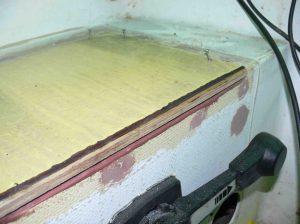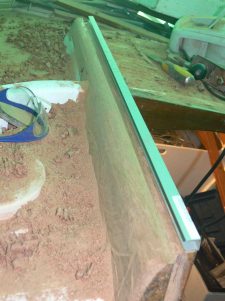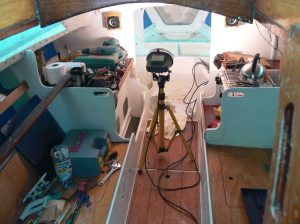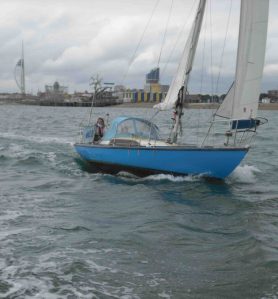Sorry I haven’t blogged recently. Things have been so busy, I just haven’t had the time or energy to sit and write it all down. I have been keeping notes and now I am compiling them into this posting. As a result of the amount of time not having written anything I have a huge amount to write to get up to date with the progress on Matilda and I apologise as this is going to be more a novel than a post.
I seem to have spent most of the time since my last post elbow deep in epoxy. Not having used it before, it has been a steep leaning curve of the properties and applications for epoxy. My Dad had lent me an old book that explained the theory of epoxy and glass fibre etc. Not the most interesting but did give me a good insite of how it could be used to good effect.
I went to the local chanderly and bought a large tub of epoxy resin and a tub of micro balloons. Looking at the prices for the mixing containers and other accessories I decided that a trip to the local Tesco’s would be better, where I bought a selection of plastic cups and spoons for measuring and mixing. This was a fraction of the price of the chandlery and has worked fine, I would recommend people look to do the same if you have a lot of epoxying to do.
I started by filling all the old holes in the deck from the old fittings that had be removed in preparation of painting the deck. I have an idea to change the layout of the fittings so would not need a lot of the holes. This was done with a thick paste of epoxy and micro ballons. After it had set I sanded tham all back so thay were flush and smooth and then refilled any voids/imperfections that were left. As I went round the boat with the paste, more and more imperfections seemed to appear, various nocks and scraps that I hadn’t taken notice of before suddenly seemed an easy job to fill but soon added up and took a while to get done. The boat now looks like it has been used as target practice by the army, with a multitude of patches all over it. I also used the filler to repair the mistake on the starboard sliding hatch mount. I had accidently cut too deeply into the side during the frenzy of sawdust that had obscured my vision when I was using my circular saw the cut the side.
To do the repair I screwed into the side of the wooden and adjusted the depth of each screw until they were at the required depth to be filled to match the other sides. I then applied several layers of epoxy. I found that because there was a significant amount of filling require it was going to need me to build it up in layers to stop it all slumping to the bottom. Once I had filled it to the required depth I sanded it back to the screws and knew it would be the correct depth.
I have found some new aluminium track from a well known DIY store which were almost the perfect length and just needed to sand back the end slightly. I mounted these by drilling and countersinking holes in the track and screwing it down so that the screw heads are flush with the track and do not obstruct the sliders
One weekend I got on board to smell something a bit “funny”, it took me a minute to realise it was diesel that I could smell. I lifted the floor boards and saw it was half filled with diesel that had leaked from the fuel tank. This resulted in me having to spend the day pumping out the deisel from with a hand bilge pump that I borrowed from my parents boat and scrubbing the bilge with various cleaning products. I pumped it into buckets before pouring it into large diesel drums that I had saved from work. It was mixed with all the dirt and grime from the engine compartment and bilge and I could only looked on with disappointment as approximately £40 of deisel was wasted.
However after leaving it overnight, I saw that the diesel had seperated from the water and rubbish that had been mixed in, so I was able to slowly pump the top layer of diesel into another container and in this way was able to save about three quarters of it. I had already been adviced to get a more substansial fuel tank instead of the flexable plastic one currently used. After researching on the internet, it was between Tek-tanks and plastimo, I initially went with Tek-tanks as their office was just up the road. I measured the space available and thought I could just about squeeze a 40 litre tank in, but after I had brought it and taken it to the boat, I found it was slightly too big. The next size down is the 33 litre but they didn’t have any in stock, which made up my mind for me. Plastimo 33 litre tank it is!
The lead for the keel has been reposition back in to the keel to ensure it was as l ow and compact as possible. I then filled all the spaces that were left with expanding foam to stop any rattling around. I’ve made the battery box and coated it in epoxy to waterproof it and stop it from rotting in the potentially damp bilge. I located the box in the keel and put the batteries in, wrapped in a plastic bag. I then squirted more expanding foam around the box, to give it a good snug fit. All thats needed now is to trim the wires to the correct length, and connect them to the battery terminals (note: to make life easier, label the end of each wire before you lead them foreward, as I now have the problem of working out which wire is which)
ow and compact as possible. I then filled all the spaces that were left with expanding foam to stop any rattling around. I’ve made the battery box and coated it in epoxy to waterproof it and stop it from rotting in the potentially damp bilge. I located the box in the keel and put the batteries in, wrapped in a plastic bag. I then squirted more expanding foam around the box, to give it a good snug fit. All thats needed now is to trim the wires to the correct length, and connect them to the battery terminals (note: to make life easier, label the end of each wire before you lead them foreward, as I now have the problem of working out which wire is which)
I have also done a quick repair to the rudder after it was damaged during the lift in for the winter. I decided that due to the limited time I would not be able to modify the rudder how I would have liked, so decide to do the minimum repair required, and then build a new one when I have more time, hopefully in time for next year. So with this in mind I simply cut off the damaged wood where it had snapped upto the first hinge. Once this was removed, the remaing bottom of the rudder seemed in good condition and so I simply rounded off the bottom and faired it in a bit, before giving it a coat of epoxy to waterproof it.
I then re-attached the pintles. As the bolts that had been used with the pintels were very corroded, I had to use new ones, but to save some money, I used some stainless steel studding from Screwfix, which I cut to length and bolted together with nylock nuts. This worked out at a fraction of the price of buying dedicated bolts and it should work just as well. All that remains is to lift and hang the rudder and give it a lick of antifouling
The locker lids have also come on quite well. I have glued and fixed in the mounting strips in the two rear lockers that I intend to fill in. It was simple a case of cutting some wooden batterns to size and gluing then in with epoxy. I have cut some plywood to size to fit into the locker space. I mixed up some epoxy and microballoons and used it to build up the level so that the plywood would sit flush with the rest of the cockpit seat. To ensure I got a good fit, I again wrapped the plywood in a plastic bag and positioned it in place and then reached underneith the smooth out the epoxy. Once the expoxy had started to set, I removed the plywood and peeled off the plastic bag and this left a perfect impression in the epoxy. I will use sealant and screws to fix it in place as this will give me the opportunity to remove it if I need to get to the throttle/ bilge pump or fuel tank on the other sided.
on quite well. I have glued and fixed in the mounting strips in the two rear lockers that I intend to fill in. It was simple a case of cutting some wooden batterns to size and gluing then in with epoxy. I have cut some plywood to size to fit into the locker space. I mixed up some epoxy and microballoons and used it to build up the level so that the plywood would sit flush with the rest of the cockpit seat. To ensure I got a good fit, I again wrapped the plywood in a plastic bag and positioned it in place and then reached underneith the smooth out the epoxy. Once the expoxy had started to set, I removed the plywood and peeled off the plastic bag and this left a perfect impression in the epoxy. I will use sealant and screws to fix it in place as this will give me the opportunity to remove it if I need to get to the throttle/ bilge pump or fuel tank on the other sided.
 The front lockers are going more slowly but I have made the starboard side locker lid and most of the frame work for it. All that is required now is to epoxy coat the few remaining bits and give it a couple of coats of deck paint. I have noticed that the lid is not a perfect fit in the space. I had expected some alterations to be needed and shouldnt be too difficult to get right when I attach the hinges
The front lockers are going more slowly but I have made the starboard side locker lid and most of the frame work for it. All that is required now is to epoxy coat the few remaining bits and give it a couple of coats of deck paint. I have noticed that the lid is not a perfect fit in the space. I had expected some alterations to be needed and shouldnt be too difficult to get right when I attach the hinges
Then all of a sudden I had a huge set back. I was walking past the boat and noticed a chunk of antifouling had flaked off. I gave it a light tap and more come away. I called over some other members and they had a look around the boat and more areas were discovered. I was adviced that all the antifouling had to be removed! As I had planned to simply apply a couple of coats over the old antifouling, this was a major job to undertake that I hadn’t wanted to do this year.
But I was lent a scraper and I set about it straight away. It all looked like it would be quite quick, but as my arms got more tired and I came across areas that were better attached, progressed slowed. It took me the best part of two days to completely remove the antifouling. On the plus side, under the antifouling was a good layer of VC tar, which I hadnt realised was there, which could account for the boat not having any signs of osmosis. There were areas on the hull, in particular around the bow that had resesses, which might have been from previous osmosis repairs that had not been finished very well, but I filled these with epoxy and microballoons and sanded them back to give the hull a nice smooth finish.
One of the theories for why the antifouling had come away was because the VC tar has a waxy/glossy finish which the antifouling didnt stick to very well. With this in mind I sanded the entire hull to give the new primer a good key. This took another day and a half as the tar had been applied quite badly and was very bumpy and need a lot of work to get it all smooth.
Now I have a nice smooth hull I will apply a primer and then two coats of antifouling, with another along the water line as recommended, and hopefully this should work better, fingers crossed.
This was a suprisingly big job even for such a small boat and really worked my arms and shoulders. I wouldn’t advice this job to anyone unless absolutely neccessary and has plenty of time. If you do, get a very good face mask due to the harmful antifoul dusk that is generated and gets everywhere!
The new launch date for Matilda is the 4th April, with gave me a bit more time to get finished and is much better than the 20th March date that I was originally given. It is still frustrating that I haven’t been able to get a lot of the work that I had hoped to get done finished but I guess I should have expected this.
I will be attaching more photos to accompany the text above soon
 y and balance the weather helm we had experienced last year. In the end we attached it on the old fitting and I would come back to the problem later.
y and balance the weather helm we had experienced last year. In the end we attached it on the old fitting and I would come back to the problem later.











